Tricolor Beech...old trend?
I almost bought a Tricolor Beech last year...held off as I wasn't sure about its performance.
Is this trendy tree worth the space?
Comments (67)
almosthooked zone5
7 years agoI haven;t had a chance to ask our neighbor if his burns but we live in zone 4/5 in BC Canada so the sun may not be as hot for as long Certainly is one of the most beautiful of the beech, He has three various kind but not near as exciting. Thanks for the input
ken_adrian Adrian MI cold Z5
7 years agoed .. the leaves fade during one season ... not over the life of the tree.. as far as i know ... hows that for a tardy reply .. lol... ken
princeton701
7 years agolast modified: 7 years agoYes - I confirm Ken's response. However, the amount of fading hasn't been a big deal for me. The degree of pink is more pink in the spring and more toward a ruby in the summer. Still very beautiful.
Compare picture of leaves posted on 5/22/2016 above & picture taken today (6/08) below. Holds its color very well this season:
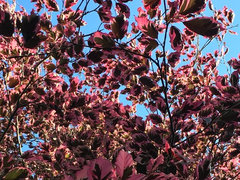
Toronado3800 Zone 6 St Louis
7 years agoEd, that thing is eye catching as Christie Brinkley early in the year. One of the few things more startling to turn a corner and see than an Ogon or Skylands.
Come late July or August they are a bit tan here even in shade and somewhat fried in the sun. And ya know what, I still tried one and will probably try another lol.
wisconsitom
7 years agoWait, let me get this straight: So, Christie Brinkley is more attractive earlier in the year? Then what happens?
Fuad Efendi
5 years agoI have two of these, < 2m high, one is in full sun on North and windy side of the house, and second one in protected area on South (partial sun). Full-sun one looks amazing colour but unfortunately insects love it too.
QUESTION: Do I need to train it? Both don't look like having leader on top right now (Mid-June).
I can publish pics; I planted it last fall; sandy area, Toronto, zone 5.ken_adrian Adrian MI cold Z5
5 years agotraining or pruning a tree.. is a function of your goals for the tree ...
my basic goal ... is to let a tree do its own thing ... subject to my pruning it up far enough that i can ride the lawnmower under it ...
of course with this tree .. with its magnificent foliage.. i tend to leave these lower than just green trees.. so i can walk up to them and eyeball some of the leaves ... in other words.. i remove the grass under them ....
all that said ... except for damaged branches.. i try not to prune on trees for at least 2 or 3 years after transplant ... every leaf is a food making machine.. so i leave them there.. while they are growing a mature root mass ...
in tree time.. whats the hurry ...
kenFuad Efendi
5 years agoI mean: right now I have two outward branches on top. And I don't have "leader" (pointing upward) on top. Should I wait for it, or just take one outward pointing branch and tie it to stake so it will become leader? I promise I'll post pictures too.
Thank you!
gardengal48 (PNW Z8/9)
5 years agoAs this is considered a shade tree and as such, will not maintain a single leader permanently (research decurrent growth habit), you just need to encourage or maintain a single leader to an appropriate height and then focus on developing structural branching. And with a tricolor beech, this is much less of an issue than say with a large growing maple, as branching typically begins much lower :-)
Fuad Efendi
5 years agolast modified: 5 years agoPictures of my two trees not having "leader" right now:
1st one, open side on North of the building, (
both) planted last fall
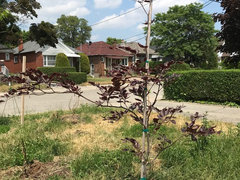
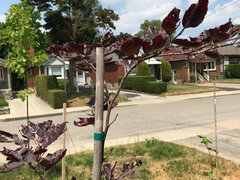
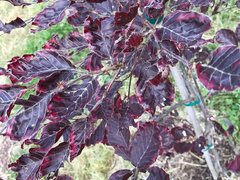
2nd one, in an part-shade island:
Fuad Efendi
5 years agolast modified: 5 years ago"As this is considered a shade tree" - I strictly disagree. Mine is in full sun; Toronto, Canada; survived -30 C Winter with 100 miles/hr storms.
In Britain, tri-color beach is used for hedges for examples (in full sun; implicitly providing shade); yes some people may consider this tree for hedges :)
Example (although not a tri-color; Fagus sylvatica purpurea):
https://www.ashridgetrees.co.uk/copper-beech-hedging-plants-fagus-sylvatica-purpurea
- in full sun.
P.S. I saw very tall trees in local nursery last fall, about 4-5 metre tall, tri-color, and other varieties, with single leader of course. Prices were up to CAD$ 10,000!
P.P.S. I edited this post to avoid confusion; "shade tree" means "tree providing shade" (and not "tree needing shade")Fuad Efendi
5 years agoPerhaps I'll need some training efforts for the tree; indeed it was tied to bamboo at the nursery because of the same reasons. I even have new red oak (planted by government) with some patch applied on top to fix broken leader.
gardengal48 (PNW Z8/9)
5 years agoA shade tree is one that creates shade, not that grows in shade :-) This is a pretty common descriptor in the tree world and just refers to a tree that develops a spreading canopy as opposed to one that is very columnar or pyramidal. Eg, conifers are not considered to be shade trees because they are firmly single leadered and do not develop a wide canopy.
And as noted, most shade trees - mostly deciduous species that form a spreading canopy - generally have a decurrent growth habit. That is, they have no defined leader after an acceptable trunk height.
cercis47
5 years ago[https://www.houzz.com/discussions/tri-color-beech-not-leafed-out-dsvw-vd~5299693[(https://www.houzz.com/discussions/tri-color-beech-not-leafed-out-dsvw-vd~5299693) I loved my Tri Color Beech, sheltered in a bed with other trees and shrubs but experienced a “sudden and unexpected death) this spring. This thread was helpful to understanding possible causes.
Fuad Efendi
5 years ago"A shade tree is one that creates shade" - thank you gardengal48 for confirmation; I misunderstood before.
At the nursery (Plants World, Eglinton West, Toronto, Ontario) I saw very tall tri-color (and other kinds) of beech tree which cannot be compared to shade trees such as maple; perhaps 1:25 in shade creating capabilities :) but under open sun I believe it will be 5x7 canopy (instead of 1x7)
My neighbour has weeping beech about 9 meters tall and 'weeping', 2 metre diameter at most; in a shade area (surrounded by tall spruce & house).
Fuad Efendi
5 years agolast modified: 5 years ago"but experienced a “sudden and unexpected death""
Common mistakes (and all my neighbours do that, including myself; but I stopped this year):
- planting tree too deep. Root crone should be above soil level at planting; after few waterings it will be at soil level (due to soil compaction). Otherwise new tiny roots will develop at soil level, and deep roots will start rotting. And roots start turning&wrapping around tree, and tree will suffocate in its' own roots over time. I didn't know this when planted my trees last year.
- adding soil around trunk, and planting flowers
- making 'mulch voulcano' around trunk. There should be no any mulch at about 2" from trunk; it should look like bagel instead of voulcano.
- Adding extra additives such as manure, compost, etc. to the soil. Soil becomes richer in this hole, and roots won't go outside in seeking nutrients. Tree can suffocate. Best to plant in the same native soil. Add manure on top layer at 2'-3' far from tree if you wish, so roots will start trying to reach better soil.
- especially in heavy soil: trying to improve it will create container for bad waters. Just plant on top of heavy/rocky soil and add more soil around.
- if container grown: try to remove all soil; if container-bound (roots are making circles around container) try to cut such roots; if hole is big but roots are too big just trim these roots. Never allow roots to make circles at planting; trim them; they should point outward. I was making so many such mistakes, with perennials too, all such plants died or just do not grow well.
Usually nurseries supply these in printed instructions but we never follow that.floral_uk z.8/9 SW UK
5 years agolast modified: 5 years agoJust a note about the claim made above that tricolor beech is used as hedging in Britain. I have never seen this. Indeed I don't recall ever seeing this tree at all and can find very few sources offering it in the U.K. Copper and green beeches are commonplace and I also know of some fern leaved beech, but no tricolors. I am sure there are some around but they must be pretty rare.
Furthermore, it is erroneous to say that hedges are planted for providing shade. If they do cast shade that is a drawback.
Fuad Efendi
5 years agolast modified: 5 years ago"Just a note about the claim made above that tricolor beech is used as hedging in Britain. " - I don't remember I've seen it neither; but we do have sample of purple hedging here in local nursery in Toronto, Canada, and they advertised it as "hedging" in resent printed flyer.
Simply Google it: https://www.impactplants.co.uk/product/instant-hedges-purple-beech-troughs/
Also, I believe I saw posts about tri-color specially trimmed columns in England (not exactly "hedging").
Quote from https://www.thespruce.com/tri-color-beech-fagus-sylvatica-3269350:
"Tri-color beech can be planted close and pruned to become a hedge, as it tolerates pruning well. However, do not prune until it has become established, which can take 1 to 2 years."
P.S.Fagus Sylvatica 'Roseo Marginata' (European Tricolor Beech) listed here (nursery in Ontario, Canada; mail order; worldwide shipping):
http://www.hortico.com/roses/view.asp?action=show&productid=8311
45mm trunk - CAD$670
tiny 60cm tree - CAD$66Listed as hardy to zone 4.
Huggorm
5 years agoI never saw any tricolor in scandinavia either, even if purple and generic green are abundant. They seem to be more of an american thing.
Mike McGarvey
5 years agoA Tri-color Beech hedge would be very prohibitively expensive for most, including me.
I wouldn't mind having one for Niwaki pruning since they take to pruning so well.
floral_uk z.8/9 SW UK
5 years agoFuad, your first link is referring to purple beech, not tricolor. Copper, or purple, beech is widespread and very common. Here's one about 5 minutes walk from my front door.

The second link, theSpruce.com, is an American website written by an inhabitant of Utah. The third link is to a Canadian nursery I doubt anyone is going to spend hundreds of dollars importing trees from there into the UK.
I live in the British Isles and my statement that tricolor beech is rare here is based on personal observation. And I have certainly never seen a hedge of it. I have found only 3 sources for tricolour beech in the UK.
Fuad Efendi
5 years agolast modified: 5 years agofloral_uk I imported many plants from UK and not only plants, and funny thing is I didn't pay VAT in UK nor HST in Canada nor any import fees (which can double VAT) :) delivery is really fast and customs are on the speed of light. Thanks to Her Majesty.
BTW here in North America we have wild beech in forests.
And in Azerbaijan you can buy jar of beech nuts for the price of three jars of sunflower seeds.
Yes I had hard time to find (to google) any image of tri-color somewhere in Europe :) I cannot find.
Fuad Efendi
5 years ago"inhabitant of Utah" created very nice "American" website LOL :)
I'd love to create such. Authentic, helpful, and generating affiliate income of course (to support big enough team).
Fuad Efendi
5 years agoQUOTE:
Several different cultivars with attractive foliage variegation are currently being sold in the U.S. under the common name of tricolor beech, including ‘Purpurea Tricolor’, ‘Roseo-marginata’ and ‘Tricolor’. Differences between these cultivars are somewhat confusing. ‘Tricolor’ reportedly originated in France in 1873. As originally described, it featured nearly white leaves spotted green with a pink margin. ‘Tricolor’ is now considered to be quite rare and may no longer be circulating in commerce. Plants sold as ‘Tricolor’ may in some cases be ‘Purpurea Tricolor’. Royal Horticultural Society Plant Finder lists ‘Tricolor’ misapplied, see F. sylvatica ‘Purpurea Tricolor’ in addition to ‘Tricolor’. Moreover, RHS currently takes the position that ‘Roseo-marginata’ (often described as the purple form of ‘Tricolor’) is in fact a synonym of ‘Purpurea Tricolor’. The bottom line is that tricolor beeches in general, regardless of assigned cultivar name, provide often stunning variegated foliage (purple/pink, green and white), particularly in spring. They are understory trees that typically grows to 30’ tall and from a distance usually project a rose foliage color in spring although the actual variegation is a bit more complicated. Leaves (to 4” long) have prominent parallel veins. Monoecious yellowish green flowers bloom in April-May but are not showy.
- from http://www.missouribotanicalgarden.org/PlantFinder/PlantFinderDetails.aspx?kempercode=d407
gardengal48 (PNW Z8/9)
5 years agoThe history of The Spruce website is long and convoluted (much as we have experienced here on GW :-) but all the landscaping/gardening advice is provided by a single freelance garden writer that has been with the organization since almost from its start as About.com. And after encountering both the website(s) and this individual hundreds of times over the years, I feel safe to say that the accuracy of the info provided there is about 50-50. So not much I would take to the bank :-)
Just saying.........
Fuad Efendi
5 years agoAnother link, seems 10x more authoritative:
http://www.greatplantpicks.org/plantlists/view/633
QUOTE:
Horticulturists in both France and Holland became aware of this unique cultivar at about the same time. First exhibited in 1885 by P. & E. Transon Nursery, Orleans, France. According to W. J. Bean in Volume II of Trees and Shrubs Hardy in the British Isles, "A similar or perhaps identical beech was exhibited by Messrs Cripps in 1888 as F. s. roseomarginata and was awarded a First Class Certificate." Hence, this cultivar has been sold in the trade under both names ever since: ‘Purpurea Tricolor’ and ‘Roseomarginata’. Now they are considered one and the same. To add to the nomenclatural confusion, although less so as it is most likely very rarely sold in the United States, is a form called 'Tricolor'. Tradition states that 'Tricolor' originated in 1873 in France with leaf variegation that is white with green spots and a rose-colored margin.
Fuad Efendi
5 years agoTwo authorities state in book "The Reference Manual of Woody Plant Propagation" that plant incompatibility issues (grafting; stock vs scion) may happen after few years of successful growth, and sudden death. And tri-color is variegated plant, grafted on regular rootstock.
davidrt28 (zone 7)
5 years agolast modified: 5 years agoThe authorative comment on prevalence in UK/British Isles collections is probably here:
http://treesandshrubsonline.org/articles/fagus/fagus-sylvatica/
I was lucky to see the gigantic one at Villa Taranto before it was destroyed by a freak tornado. Probably about 75' with a 1m diameter trunk. Still plenty of pink on the foliage in September. Stunning.
It wasn't even very old...planted in the 1950s IIRC. I have a picture of the tag with the date. Proof they can get large, quickly, in a salubrious climate with perfect temps and 70" of rain a year. And good, deep schist or loam soil, too, probably. OTOH I know of one in Northern Virginia (red clay, steamy but drought prone summers) that is roughly 30 years old but only 20' at most.
floral_uk z.8/9 SW UK
5 years agolast modified: 5 years agoI am not contending there are none in the U.K. but I do know that I have never seen one personally, that there are very few sources selling them in the country and that specimens are relatively rare. I also know that the statement 'In Britain, tri-color beach is used for hedges for examples (in full sun; implicitly providing shade);' is wrong. They're far too rare and expensive to be used for hedging.
I am now on the lookout for an example of tricolour beech. So far no joy. But I do know of two Asplenifolias in the next street along from mine.
p.s. I now find that the national arboretum at Westonbirt has 3 specimens. Maybe I'll see them there.
cercis47
5 years agoVery interesting thread. When I cut down our tree this fall, I will do some detective work and report back.
Huggorm
5 years agolast modified: 5 years agoIt wasn't even very old...planted in the 1950s IIRC. I have a picture of
the tag with the date. Proof they can get large, quickly, in a
salubrious climate with perfect temps and 70" of rain a year. And good,
deep schist or loam soil, too, probably. OTOH I know of one in Northern
Virginia (red clay, steamy but drought prone summers) that is roughly 30
years old but only 20' at most.My experience is that they need water more than nutrients to thrive. They seem to grow best on hill sides, with a lot of flowing groundwater. As long as they have that they can grow in really poor and acidic soil, but of course they will grow faster in richer loam
floral_uk z.8/9 SW UK
5 years agolast modified: 5 years agoTo support what Huggorm says. The natural beech woods in Southern England often grow in Beech 'hangers'. These are hanging woods ie on steep slopes near hilltops on chalky soils. The soil is not rich but there is a constant supply of ground moisture. They were the basis of an important furniture industry in Buckinghamshire in the past. If anyone has read the Natural History of Selborne by Gilbert White they'll be familiar with beech hangers.
Fuad Efendi
5 years agolast modified: 5 years agoBTW "Beech Tree" is called "Iron Tree" in local dialect in Azerbaijan (if I am not mistaken); it is really *exceptionally* strong wood, you will have really hard time to cut from it for instance chess figures or anything.
Some pictures from local nursery, 'fountain' and 'purple':


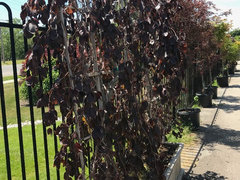



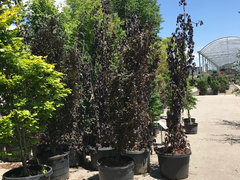
And from local park (Markham, Ontario, close to Toronto):
Huggorm
5 years agoBTW "Beech Tree" is called "Iron Tree" in local dialect in Azerbaijan (if I am not mistaken)
Are you sure that isn't parrotia persica? It's sometimes called "persian ironwood". Of course it could be a coincident.
Fuad Efendi
5 years agoYes I am mistaken; "persian ironwood" is not the same as "fagus":
https://en.wikipedia.org/wiki/Witch-hazel
Fuad Efendi
3 years agoHere is my Fagus Sylvatica Tri-Color, front-yard of house (North side), full-sun in this specific location in Summer & part shade in Winter, absolutely open to strong winds.
Picture from November-2019, last year I removed supporting bamboo stake in Spring and it became very strong trunk in few months; note how many side branches it has:
I've read somewhere, in order to make it taller fast one needs to prune it accordingly. So, I removed this weird side branches two months ago (which I cannot keep anyway: will take neighbour's driveway), almost 65% of wood was removed; I kept only branches on top of tree.
It just started leafing out, it was bended, so I created some support for it, and really it looks now 1-meter taller than last year; total growth of each branch is already 1 foot, and I hope for a leader strike in few months:
Interesting weeping habit.
I have two of such trees, another one is in the corner of backyard, in the cozy pocket, partial shade, no strong winds there maybe that's why it has weaker trunk; colour of trees is different, leaves are bigger in part-shade tree. Both trees came from same nursery. Third season in the ground.
Perhaps I can expect 2 feet growth this year :)Plasko 20
3 years agoI have often dreamed about owning a tri-coloured beech. Pink leaves are stunning. But it gets just too tall and wide, sadly (and I would feel cruel confining it to a container to try and force it to be small). However, now I am looking into the Japanese Maple Acer "Rainbow". Also has pink variegated leaves throughout summer! And only gets to be 8-10ft tall, and 4-5ft wide. Great for a small to med-sized garden, if you are in the right zone.
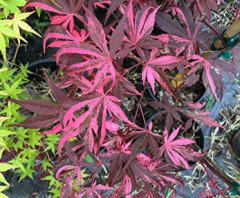
Fuad Efendi
3 years agoAnd here is mine:
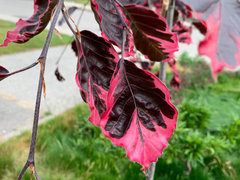
I need to find way to fight insects... looks like yellow hornets like it too, see top-right corner, 25% of leaf is gone alreadyPlasko 20
3 years agoFor insects:
https://www.amazon.com/gp/product/B00192ANXM/ref=ppx_yo_dt_b_asin_title_o02_s00?ie=UTF8&psc=1
For worm/caterpillar/moth:
For fungus:
https://www.amazon.com/gp/product/B00BSH0UGS/ref=ppx_yo_dt_b_search_asin_image?ie=UTF8&psc=1
Fuad Efendi
3 years agoUnfortunately Bonide and similar not available in Canada... so I was forced to order Bayer's from eBay :(
Karen Smith
3 years agoHave any of you seen a tri color beech grown successfully in full shade? Also - I'm seeing a lot of differing final height specs. Some say up to 40ft and other websites are referring to it as a "small tree" and perfect for a "small lot" or "urban space." Assuming if I stuck it in shade it would end up smaller and that is ok - I just don't want it to die or just be ridiculously too small for the space I'm looking at (near large pines which will compete).
Overall I am looking for a tee under 25ft for a shady spot. I'd love a bit of color to break up the pines and oak around it (American SE - zone 6b - elevation 2500ft). I already have several native serviceberry, dogwood, and redbud on the lot as well as an eastern hemlock so I thought this might add some spice. I noted a landscape group put in a lot of beech in very deep shade around the hospital I work at and was looking into beech as a possibility and came to this cultivar due to smaller size and fun foliage.Plasko 20
3 years ago'Acer campestre carnival' has white leaves and adores full shade. Slow grower, though. But breathtaking.
ken_adrian Adrian MI cold Z5
3 years agokaren.. you should have started your own post ... especially if you want personal landscaping ideas ...
trees NEVER stop growing.. in your lifetime ... there is no ultimate height estimate ... and annual growth is location dependent ... meaning length of growing season ... etc ... your vague description of where you are doent help me.. help you ...
this tree will not color fully in too much shade... but it will still be a purplish tree with some edging ...
the upside.. the white on this tree tends to burn in the heat of summer ... and that will be retarded in more shade ...
in my world.. warped as it is.. i tend to plant gorgeous plants that really 'pop' in the location.. even if i have to cut it down in 10 or 20 years ... lifes to short to settle for an ugly little plant.. just because it fit the spot ...
kenPlasko 20
3 years agoYeah, well lucky you can pay thousands to safely cut down a tree and remove a tree stump. The rest of us are not rolling in buckets of cash, sadly, ken.
Fuad Efendi
3 years agolast modified: 3 years agoI have two trees from the same nursery, bought at same year. One receives sun 12-14 hours a day, zero shade, and insects love its' leafs, so I watered it with 1g of Bayer's insecticide (mixed in 5 gallon water) a month ago and it helped. This tree has smaller leafs. Second one, in 6-8 hours per day of sun, has twice larger leafs, and much less insect damage. No idea why. Both grow differently.
"full-sun" tree has slightly weeping habit, and since I started training it and constant watering, it already grew 1.5' new branches this year which considered very fast.
This picture was made 4 weeks ago; "full-sun"; top branches now started straightening up; and after 1st Spring growth strike I have new strikes at almost all branches (thanks to constant water dripping). I trimmed 2/3 of side branches this year and attached bamboo stick and just this already made it looking few feet taller.
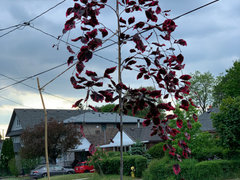
"part-sun" tree has much bigger leafs and deeper colour, not weeping at all, and grows much slower.Yes, as each beech tree it can reach 40'-60' in about 40-60 years, considering tri-color was discovered recently... in 1873, France... then should find huge trees in France?
Tri-Color Beech is cultivar, mostly grafted on standard beech, so it all depends on graft quality and rootstock. SOme rootstock may grow faster; some may push tree higher.
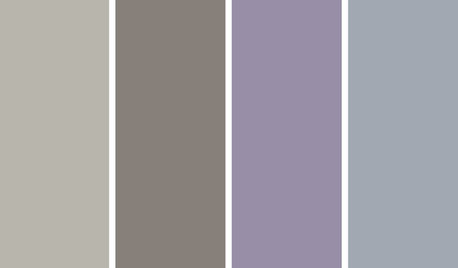
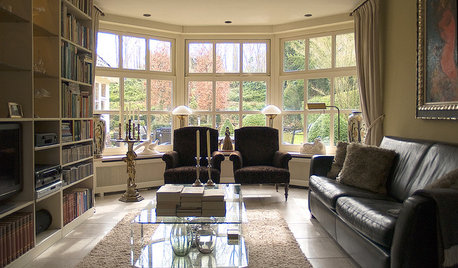
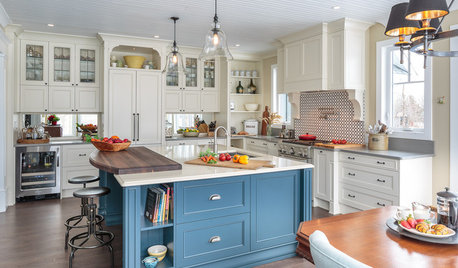
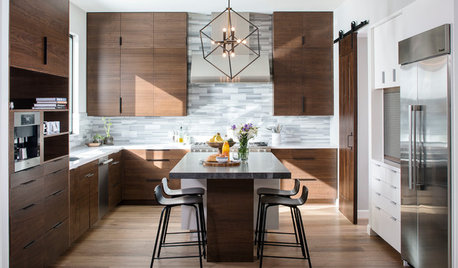
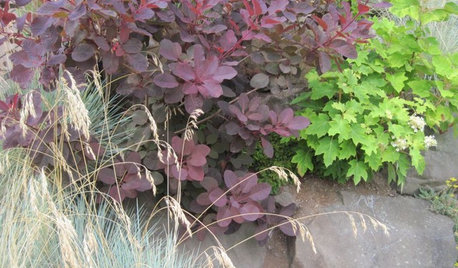
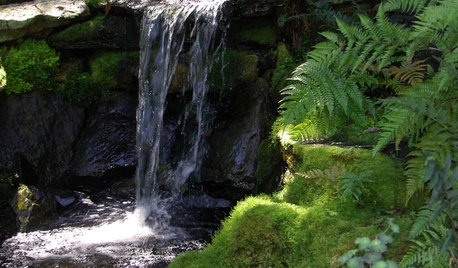
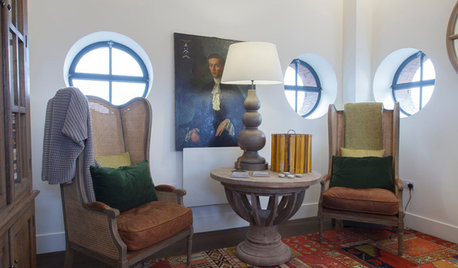
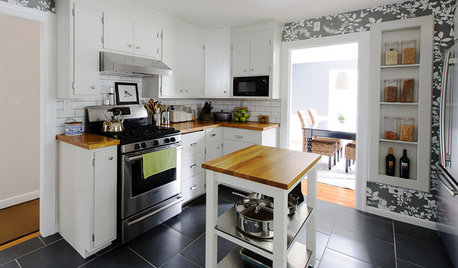

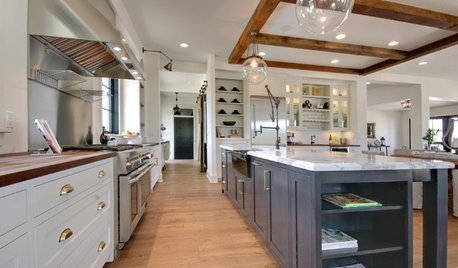






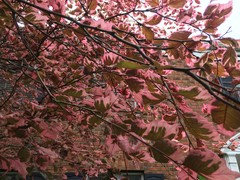
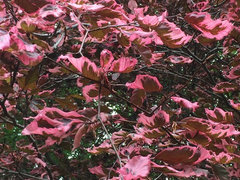

ken_adrian Adrian MI cold Z5